Toy photography lends itself to whimsy, and LEGO minifig photography even more so, but Renner_Lego’s work takes the potential for playfulness up a notch with the illusion of freezing action through compositing.
It’s his photos with food in particular that caught my attention. Far from the unimaginative minifig-in-your-lunch snapshots taken with a phone, Renner_Lego’s concepts are artful and diligently executed.
“What I care most about is imagination and ideas. I think about it from the viewpoint of the minifig and imagine what happens at that time. Then I take a picture that is close to what I imagined. I take photos like the minifig is alive. And for people and minifigs, I think food is very important.”
One of my favorite photos in his food series is of the pilot on a Pringle chip. The thrill of the ride on the minifig’s face, the position of the minifig and the chip so that the pilot appears to be looking slightly downward, the opened Pringles can on its side as if it were a cannon, and the placement of Pringles canisters in the background to give the photo some depth: these were all carefully considered decisions made by Renner_Lego.

This photo, among several in Renner_Lego’s series, exemplifies many of LEGO’s own values: Creativity, Imagination, Fun and Quality. Perhaps that’s why, at just 19 years old, this Japanese student of photography has already seen some commercial success with his minifig photography; he sold 65 photos in 6 hours at the recently concluded Japan Brickfest. “I can’t believe it and I’m very happy! Customers were various ages. But the mother who brought the child bought the most.”
In this post, Renner_Lego breaks down his photo of the waiter slipping and sugar cubes flying.
The setup
When doing composite work, photographers must previsualize their ideas and plan their shots with post-production in mind. In Renner_Lego’s photos, that almost always involves using a tripod and maintaining the same camera and light settings to shoot a few versions of a scene for editing later.
For this photo, he set up the entire scene on a table in his living room. The minifig and sugar cubes were held in position with masking tape and paper clips for the first shot, and then removed for the second shot.
Both of the photos were taken with a Canon EOS 750D (or EOS Rebel T6i in other parts of the world) with a Tamron 90mm macro lens at F3.5 ,1/30 and ISO 100.
To light the scene, Renner_Lego placed two NEEWER CN-160 LED lights with diffuser panels on opposite sides, one on the table and another on a tripod. You can clearly see the reflections of these two lights on the lid of the smaller jar in the background.
This particular LED light is popular with videographers because it isn’t heavy, it’s portable, cheap (about $20 USD), works well and has a built-in dimmer switch. It’s a great piece of gear to add to any toy photographers kit. I have something similar, a Godox LEDP120-C, that I have been experimenting with for my nascent videography endeavor but haven’t yet used in any photography work.
Post-processing
To remove the tape and paper clips from the final image, Renner_Lego used Photoshop to create a composite from the two photos he took above by using some basic cloning, masking and brush work.
If you’re a Photoshop novice, here’s a quick demo of how to use layer masks and brushes to manually hide and reveal elements:
You can use layer masks in GIMP, a free alternative to Photoshop, if you’re not already a Creative Cloud subscriber. I also highly recommend Chris Orwig’s Photoshop for Photographers: Compositing on Lynda.com if you want to master this technique.
Overall, the final image took him about 3 hours to set up, shoot and edit.
The Renner_Lego challenge
Being able to do some basic compositing in Photoshop, GIMP or other powerful photo editing software affords artists more freedom in conceptualizing and producing better images. What minifig photographer doesn’t want that?
For this challenge, I am going to get my minifigs to do something gravity-defying with food and I want you to join me. Go grab some paper clips, toothpicks, tape, putty or what have you and get to work putting together a novel scene involving food with your minifigures. It should go without saying but be creative! That means definitely no raspberry hats.
Post your photos on Instagram or Twitter and use the hashtag #inthestyleof_Renner_Lego so Renner_Lego and I can find your work. We’ll be looking for the best of the photos to feature on Four Bricks Tall when this challenge ends on July 12.
Are you with me?
More from Renner_Lego:


